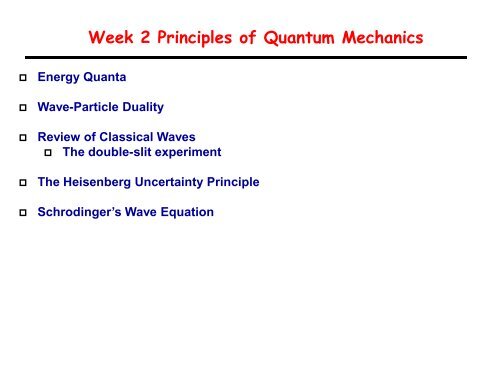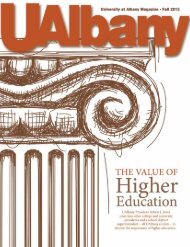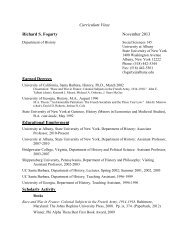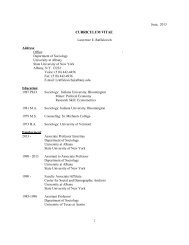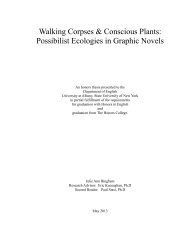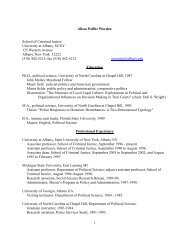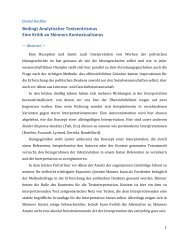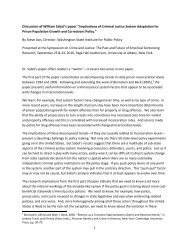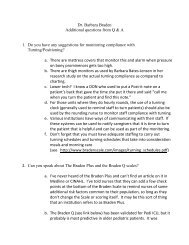Review of Classical Wave
Review of Classical Wave
Review of Classical Wave
Create successful ePaper yourself
Turn your PDF publications into a flip-book with our unique Google optimized e-Paper software.
Week 2 Principles <strong>of</strong> Quantum Mechanics<br />
<br />
<br />
<br />
<br />
<br />
Energy Quanta<br />
<strong>Wave</strong>-Particle Duality<br />
<strong>Review</strong> <strong>of</strong> <strong>Classical</strong> <strong>Wave</strong>s<br />
The double-slit experiment<br />
The Heisenberg Uncertainty Principle<br />
Schrodinger’s <strong>Wave</strong> Equation
Planck’s Energy Quanta: Photoelectric Effects<br />
• The photoelectric effect shows the discrete nature <strong>of</strong> the photon and<br />
demonstrates the particle-like behavior <strong>of</strong> the photon .<br />
• Einstein explained the photoelectric effect by postulating that, in a<br />
photon, the energy was proportional to the frequency (1905).
Compton Effect<br />
• In this experiment, an x-ray beam is incident on a solid. A portion <strong>of</strong> the<br />
beam was deflected and the frequency <strong>of</strong> the deflected wave was shifted<br />
compared to the incident wave. The Compton effect, was explained by<br />
proposing that photons carry momentum.<br />
• If a photon collides with an<br />
electron, the wavelength and<br />
trajectory <strong>of</strong> the photon is<br />
observed to change. The<br />
wavelength shift <strong>of</strong> light after<br />
collision with an electron is<br />
consistent with a transfer <strong>of</strong><br />
momentum from a photon to<br />
the electron. The loss <strong>of</strong><br />
photon energy is reflected in a<br />
red shift <strong>of</strong> its frequency.
De Broglie’s <strong>Wave</strong>-Particle Duality Principles<br />
• In 1924. de Broglie postulated the existence <strong>of</strong> matter waves. He suggested<br />
that since waves exhibit particle-like behavior, then particles should also be<br />
expected to show wave-like properties.<br />
• The hypothesis <strong>of</strong> de Broglie was the existence <strong>of</strong> a wave-particle duality<br />
principle. The momentum <strong>of</strong> a photon is given by<br />
• Then, de Broglie hypothesized that the wavelength <strong>of</strong> a particle can be<br />
expressed as (de Broglie wavelength <strong>of</strong> the matter wave).
Davisson-Germer Experiment
Electron Diffraction through Double Slits<br />
• <strong>Classical</strong>ly, we would predict that electrons passing through slits in a screen<br />
should continue in straight lines, forming an exact image <strong>of</strong> the slits on the rear<br />
screen. In practice, however, a series <strong>of</strong> lines is formed on the rear screen,<br />
suggesting that the electrons have been somehow deflected by the slits.
<strong>Review</strong> <strong>of</strong> <strong>Classical</strong> <strong>Wave</strong><br />
• A wave is a periodic oscillation. It is convenient to describe waves using<br />
complex numbers. For example consider the function<br />
where x is position. This function can be plotted on the complex plane as<br />
a function <strong>of</strong> position, x. The phase <strong>of</strong> the function is the angle on the<br />
complex plane.
<strong>Review</strong> <strong>of</strong> <strong>Classical</strong> <strong>Wave</strong><br />
• The wavelength is defined as the distance between spatial repetitions <strong>of</strong><br />
the oscillation. This corresponds to a phase change <strong>of</strong><br />
• This wave is independent <strong>of</strong> time, and is known as a standing wave.<br />
• We could define a function whose phase varies with time:<br />
• We define the period, T, as the time between repetitions <strong>of</strong> the oscillation
<strong>Review</strong> <strong>of</strong> <strong>Classical</strong> <strong>Wave</strong><br />
• We can combine time and spatial phase oscillations to make a traveling<br />
wave.<br />
• The intensity <strong>of</strong> this wave is uniform everywhere it is known as a<br />
plane wave.<br />
• A plane wave has at least four dimensions (real amplitude, imaginary<br />
amplitude, x, and t), so we plot planes <strong>of</strong> a given phase. These plane waves<br />
move through space at the phase velocity <strong>of</strong> the wave
The Double Slit Experiment<br />
• Far from the double slit, the electrons from each slit can be described by<br />
plane waves, where s is the separation between the slits and L is the<br />
distance to the viewing screen. When the planes <strong>of</strong> constant phase collide,<br />
a bright line corresponding to a high intensity <strong>of</strong> electrons is observed.
• At the viewing screen we have
The Double Slit Experiment<br />
• At the screen, constructive interference between the plane waves from<br />
each slit yields a regular array <strong>of</strong> bright lines, corresponding to a high<br />
intensity <strong>of</strong> electrons. In between each pair <strong>of</strong> bright lines, is a dark band<br />
where the plane waves interfere destructively, i.e. the waves are out <strong>of</strong><br />
phase with one another.<br />
• The spacing between the bright lines at the viewing screen is<br />
• It is notable that the fringe pattern is independent <strong>of</strong> intensity. Thus, the<br />
interference effect should be observed even if just a single electron is<br />
fired at the slits at a time.<br />
• The only conclusion is that the electron – which we are used to thinking<br />
<strong>of</strong> as a particle - also has wave properties.
• The cumulative electron distribution after passage through a double slit.<br />
Just a single electron is present in the apparatus at any time.<br />
A. Tanamura et al., Am. J. Phys.<br />
57, 117 (1989).
The Electromagnetic Spectrum
Heisenberg’s Uncertainty Principle<br />
• Heisenberg’s uncertainty principle, given in 1927, applies primarily to very<br />
small particles, and states that we cannot describe with absolute accuracy<br />
the behavior <strong>of</strong> these subatomic particles.<br />
• The uncertainty principle describe a fundamental relationship between<br />
conjugate variables, including position and momentum and also<br />
energy and time.<br />
• The first statement <strong>of</strong> the uncertainty principle is that it is impossible to<br />
simultaneously describe with absolute accuracy the position and<br />
momentum <strong>of</strong> a particle.<br />
• The second statement <strong>of</strong> the uncertainty principle is that it is impossible to<br />
simultaneously describe with absolute accuracy the energy <strong>of</strong> a particle<br />
and the instant <strong>of</strong> time the particle has this energy.
Heisenberg’s Uncertainty Principle<br />
• The uncertainty principle is not very relevant to everyday objects
Schrodinger’s <strong>Wave</strong> Equation<br />
• The various experimental results involving electromagnetic waves and<br />
particles, which could not be explained by classical laws <strong>of</strong> physics, showed<br />
that a revised formulation <strong>of</strong> mechanics was required.<br />
• Erwin Schrodinger (1926), provided a formulation, called wave mechanics,<br />
which incorporated the principles <strong>of</strong> quanta introduced by Planck, and the<br />
wave-particle duality principle introduced by de Broglie.<br />
• Based on the wave-particle duality principle. we will describe the motion <strong>of</strong><br />
electrons in a solid or nanostructure by wave theory. This wave theory is<br />
described by Schrodinger's wave equation.


